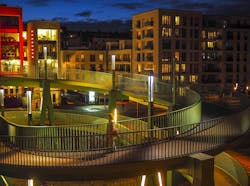I confess that I am "upcycling" a newsletter column from this week on the last blog of the year. When time is running short, repurpose and win, I say!
When I look back at our coverage of LEDs in general illumination, decorative, façade, and entertainment/sports lighting, I am struck by how much solid-state lighting (SSL) systems design knowledge and implementation has evolved compared to when I started working with LEDs Magazine eight years ago. And the LED transition has encountered its share of controversies.
Let’s examine museum lighting, for example. In early 2013, LEDs reported on a study popularized in the mainstream press that put LEDs in a “bad light” when it came to preserving artwork. It turned out, though, the reported study was not designed using LEDs in the experiment but rather various wavelength filters combined with a high-intensity xenon lamp to mimic how researchers thought white-LED lights would behave — but they didn’t account for spectral differences.
The initial clamor in 2013 did give way to thoughtful design and application of quality, stable SSL products in museums, galleries, and historic sites such as the former Philips Lighting project at Amsterdam’s Rijksmuseum and Zumtobel’s approach to Vienna’s Kunstkammer. More recently, contributing editor Mark Halper shared a contemporary design scheme at the Roman Domus Aurea, which challenged the project team with its underground siting. Not only did the architects and designers require physically robust lighting, but they also faced replicating a natural light experience that would have shone through an oculus as well as the torchlight that would have illuminated many chambers during Roman Emperor Nero's reign. Still, collaborators met the brief head on with Bluetooth-based controls, a mix of warmer and cooler CCTs, and minimal structural impact inside the historic palace.
Granted, this is a very high-end application with extremely stringent light-quality standards and the added pressure of maintaining architectural and artwork integrity. But the implications of energy-efficient, controlled, quality illumination delivered where and when it is needed are far-reaching, across many strata and even the most utilitarian applications.
Public lighting in the UK, for instance, came under scrutiny after the homicide of a young Londoner early in 2021. Not long after, the non-profit Centre for London think tank extolled the benefits of proper city lighting, encouraging a modern and unified lighting plan to improve quality of life across the metropolis, in a report it issued to London officials.
We don’t as a general collective have it all worked out round the globe. But the good news is that we have reason for optimism that SSL combined with controls will continue to positively impact society across all walks of life, especially when we learned that even the smallest of communities committed to balancing energy consumption, visual acuity, safety, and costs in 2021. That’s a far cry from the large-scale SSL projects we tend to see — but no less important to the people who live, work, and support those communities.
I'm looking forward to cheering the close of 2021 and to seeing what 2022 holds for this industry, still full of inspiration and ingenuity.
CARRIE MEADOWS is associate editor of LEDs Magazine, with 20 years’ experience in business-to-business publishing across technology markets including solid-state technology manufacturing, fiberoptic communications, machine vision, lasers and photonics, and LEDs and lighting.
For up-to-the-minute LED and SSL updates, why not follow us on Twitter? You’ll find curated content and commentary, as well as information on industry events, webcasts, and surveys on our LinkedIn Company Page and our Facebook page.






